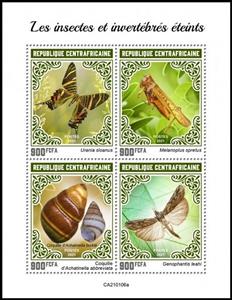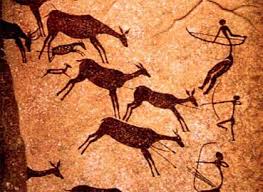Mini Sheet: Various Insects (Central African Republic 2021)
Various Insects (Central African Republic 2021)
29 January (Central African Republic ) within release Extinct Insects and Invertebras (2021) goes into circulation Mini Sheet Various Insects face value 4*900 Central African CFA franc
| Mini Sheet Various Insects in catalogues | |
|---|---|
| Colnect codes: | Col: CF 2021-11 |
Mini Sheet is square format.
Although this edition is authorized by the Central African Postal Administration, it was not sold in Central Africa, but only distributed to the novelty trade by the Central African Philatelic Agency.Also in the issue Extinct Insects and Invertebras (2021):
- Souvenir Sheet - Mecodema punctellum face value 3,600;
- Mini Sheet - Various Insects face value 4*900;
Mini Sheet Various Insects it reflects the thematic directions:
Insects (from Latin insectum, a calque of Greek ἔντομον [éntomon], "cut into sections") are a class (Insecta) of hexapod invertebrates within the arthropod phylum that have a chitinous exoskeleton, a three-part body (head, thorax and abdomen), three pairs of jointed legs, compound eyes and one pair of antennae. They are the most diverse group of animals on the planet, including more than a million described species and representing more than half of all known living organisms. The number of extant species is estimated at between six and ten million, and potentially represent over 90% of the differing animal life forms on Earth. Insects may be found in nearly all environments, although only a small number of species reside in the oceans, a habitat dominated by another arthropod group, crustaceans. The life cycles of insects vary but most hatch from eggs. Insect growth is constrained by the inelastic exoskeleton and development involves a series of molts. The immature stages can differ from the adults in structure, habit and habitat, and can include a passive pupal stage in those groups that undergo 4-stage metamorphosis (see holometabolism). Insects that undergo 3-stage metamorphosis lack a pupal stage and adults develop through a series of nymphal stages. The higher level relationship of the Hexapoda is unclear. Fossilized insects of enormous size have been found from the Paleozoic Era, including giant dragonflies with wingspans of 55 to 70 cm (22–28 in). The most diverse insect groups appear to have coevolved with flowerin plants.
Prehistory, also called pre-literary history, is the period of human history between the first known use of stone tools by hominins c. 3.3 million years ago and the beginning of recorded history with the invention of writing systems. The use of symbols, marks, and images appears very early among humans, but the earliest known writing systems appeared c. 5,200 years ago. It took thousands of years for writing systems to be widely adopted, with writing spreading to almost all cultures by the 19th century. The end of prehistory therefore came at different times in different places, and the term is less often used in discussing societies where prehistory ended relatively recently.


